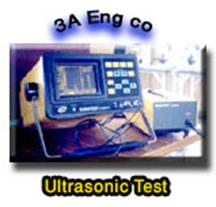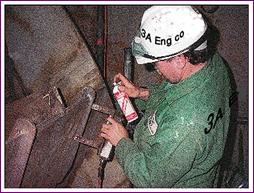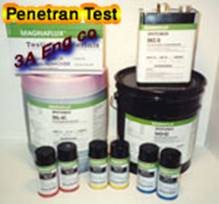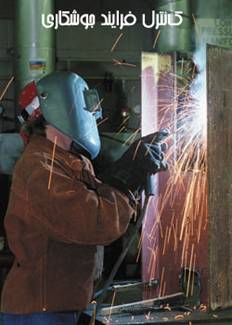شما اینجا هستید: صفحه اصلی / شرکت ها و واحد ها /شرکت ها / بخش مسکن شرکت سحاب فرهنگیان / اطلاعات جامع مسکن بویژه فاز7 / مدیران بخش مسکن
| N-D-T 3D (PLYSTYREN) ARMELAT |
|
N-D-T
N.D.Tمخفف کلمات (Nondestructive Test) به معنی آزمایشات غیرمخرب جوش می باشد. جوشکاری درابتدا جهت وصله قطعات وکارهای تعمیری مورد استفاده بود و به ندرت درساخت سازه های فولادی نظیرساختمان ها ، پلها وسازه های صنعتی همانند مخازن، سیلوها ، مخازن تحت فشار،خطوط لوله آبرسانی ، سوخت رسانی و سایر موارد مشابه که خرابی و شکست آنها موجب فجایع جبران ناپذیر می گردید ، مورد استفاده قرار می گرفت. از هنگام کاربردجوش و جوشکاری به عنوان ابزار ساخت اسکلت های فولادی ، مقاوم بودن درز اتصال جوش شده در مقابل شرایط بهره برداری وشرایط بحرانی ( مثل نیروهای زلزله) امر مهمی گردید. به همین جهت در کنار گسترش کاربردجوش، باید روشهایی جهت کنترل و تعیین کیفیت جوش وهمچنین ارزیابی و تأیید کار تمام شده ، تدوین می شد. لذا قابلیت های اعتماد از عملکرد سازه ها ایجاب می نماید که فلزجوش و درز جوشکاری شده ازلحاظ مقاومت ، سلامت و دیگر خصوصیات مورد نظر سا زه ای ، عاری بودن از عیوب جوشکاری همانند عیوب ، Longtiodinal Cracks - Transverse Craks-Star Cracks- Internal Concavity-Surface Iregularity-Undercut - Slag Inclusion-Porosity-Worm Hole-Lack of Fusion-procitys-Lack of penetration مورد آزمایش و امتحان قرار گیرد. دراین راستا بخش مسکن شرکت سحاب فرهنگیان استان کرمان جهت اطمینان کامل از انجام فرایند جوشکاری اسکلتهای دردست ساخت نسبت به انجام آزمایشات غیرمخرب جوش با استفاده ازآخرین تکنولوژی روز وبا استفاده ازمتخصصین مجرب نسبت به امرکنترل کیفیت جوش نموده است لذا دراین فرایند آزمایشات التراسونیک جهت انجام کنترل جوشهای نفوذی وآزمایشات ذرات مغناطیسی جهت تشخیص عیوب زیرسطح وهمچنین انجام آزمایشات مایعات نافذ را جهت عیوب سطحی جوش انجام وپس ازارزیابی نتایج اقدامات ضروری را جهت برطرف کردن واصلاح عیوب جوش بعمل می آورد.  Ultrasonic Test آزمایش فراصوت یا التراسونیک  Magnetic Test آزمایش ذرات مغناطیسی  Penetran Test آزمایش مایعات نافذ  Visual Testبازرسی چشمی |
| 3D (PLYSTYREN) (3D)بعنوان سیستمهای نوین ساختمانی به عنوان دیوارهای باربر وجدا کننده وسقف وکف ساختمان به طوردلخواه کاربرد داردوشبکه مش بیرونی وداخلی صفحات (هردوطرف)بابتن ریزدانه بتن پاشی (شاتکریت) می شود،ضخامت بتن درهریک ازلایه های طرفین حدود 3تا4 سانتی مترمی باشد . ساختمانهای احداثی با 3Dرفتار سازه ای حعبه ای شکل(BOX) دارند.دراین نوع ساختمانها انتقال نیروبه صورت خطی انجام نمیشود،بلکه به صورت سطحی است،درساختمانهای باسازه تیروستون انتقال باربه صورت خطی است یعنی بارهرطبقه ازطریق تیرها به ستون وازستونها به فونداسیون منتقل میشود،درساختمان های تیروستونی درهنگام وقوع زلزله باتخریب سازه ای درهریک ازاجزااعم ازتیرها یاستونها تخریب کلی وفروریزی ناگهانی صورت میگیرد،اما درساختمانهای احداثی با( (3D چنانچه دراتصال یک دیواریاسقف یاکف تخریبی ایجادشود سایراحزاءباروارده را تحمل می نماید ومانع ازتخریب کلی ساختمان میشوند. اتصال ساختمان درسازه های اسکلت فلزی یابتنی پیش ساخته موضعی ومحدود است وبه خصوص اگرصعف جزئی درهریک ازاتصالات وجودداشته باشددراثر نیروی جانبی، ساختمان را درمعرض تخریب وآسیب جدی قرارمیدهد،امادرساختمانهایی که باروش( (3Dساخته میشوند یکپارچگی اتصالات یکی ازمهمترین ویژگی های این روش ساختمانی میباشد وهمین موضوع توجه مهندسین ساختمان را به این روش جلب کرده است. حال به تفکیک موضوع می پردازیم : الف : عده ای ازسازندگان درساختمان سازی صنعتی ازقطعاتی به نام ساندویچ پانل پلی اورتان استفاده مینمایند که یکی ازمواد مصرفی درتولید عایق اینگونه پانلها که اختصارا (P.U.) نامیده می شود ایزوسیانات وماده پلی یور است ودیگری که به عنوان مکمل یا اکتیو مورد استفاده قرار میگرفت گازفریون 11 به میزان 10 کیلوگرم درهرمترمکعب عایق می باشد که با توجه به تولید پانلهای P.U.توسط کارخانه بزرگ وچندین کارگاه کوچک درکشور که سالانه حدود 1500000 وارد مترمربع میباشد وجهت تولید این مقدارP.U. حدود 1500 تن گازفریون 11 واردچرخه آلاینده های محیط زیست میشود ،مضافا اینکه هنگام تولید پانل وپس ازآن خطرگاز سیانورناشی ازماده ایزوسیانات انسانها،محیط زیست ودیگرجانداران راتهدید میکند. چنانچه درپوشش دیواروسقف سالن های سوله ساندویچ پانلهای پلی استایرن جایگزین پانل های P.U.شود علاوه برحمایت ازتولید داخلی ازخروج مقدار قابل ملاحظه ای ارز نیز جلوگیری خواهد شد،زیرا مواد اولیه P.U.کلاوارداتی است. ب : حال اگردرساختمان سازی به جای آجرودیگرمصالح پانل های عایقدار"پوما"راجایگزین کنیم به جهت عایق شدن دیوارها وسقف ساختمانها،مصرف سوخت کاهش می یابد درنتیجه دود آلاینده بخاری ها،آبگرمکن هاوشوفاژها به میزان زیادکاهش می یابد وطبعادرکاهش آلودگی ازناحیه نیروگاه های گازی نیزشاهد وضعیت بهتری خواهیم بود وشاید دود دودکشهای بلند کارخانه های تولید آجرنیزکاهش یابد. 1- نفوذآلودگی صوتی شهرهای بزرگ به منازل شهروندان کاهش می یابد وآنها درمحیط آرام تری به استراحت وتجدید قوا می پردازند. 2- به طورکلی درهزینه های بخش ساختمان سازی وصنایع جنبی صرفه جویی قابل ملاحظه ای خواهیم داشت |
| آرملات چیست ؟ ARMELAT 1-What is “Armelat”? Armelat is a layer of high strength concrete that serves as flooring and provides a dense abrasion resistant wearing surface on a concrete base. its thickness is 1-2 cm. 2- What is the characteristic of the base that Armelat is placed on? It should be placed on fresh concrete. Although Armelat is executable on old concrete slabs with aid of an intermediate concrete screed with minimum 80mm thickness. 3- When the Armelat layer should be applied? After initial set and before final set of concrete layer. The concrete slab will be known as “old concrete” if it passes 12 hours from placing. 4- Is it possible to apply “Armelat” on an old base? Although it is possible with aid of concrete adhesives, but it is not recommended. 5- How much is the thickness of the intermediate layer between old slab and “Armelat” topping? At least 80 mm. 6- Where is the main application area of “Armelat”? Industrial floor surfaces subjected to heavy or frequent traffic and heavy abrasive loads. 7- Can Armelat serve as a “decorative flooring”? Yes, by using different colors and frame works that are made of mineral stones, which permit us to form different geometrical shapes, it is possible for Armelat to serve as a decorative flooring. 8- Is it possible to have a completely uniform flooring by Armelat? No, Joint construction is an inevitable operation in flooring. 9- Why are the contraction joints provided? Because of “drying shrinkage” of concrete we encounter contraction cracks in concrete. Contraction joints are essentially weakened planes constructed in a concrete member to regulate the location of the cracking and oblige the cracks to occur in joints and will not create a crack somewhere else on the slab. 10-Contraction joints spacing are affected by which factor? It depends on to slab thickness. By ACI recommendation, the maximum joints spacing should be 24 to 36 times the thickness of slab. 11- How much is the maximum joint spacing by ACI recommendation? 15 feet 12- Is there any recommendation for the ratio of the long to width of Armelat topping panels? As a general rule, ratios of the long to short side should not exceed 1.25 to 1.5. ACI 302 1R states that cracking may become excessive for ratios greater than 1.5. 13- Is it possible to reduce the structural concrete thickness by applying armelat? Armelat should not be replaced for structural concrete, but we can reduce the thickness of structural concrete as much as Armelat topping thickness. 14-Is it possible to apply Armelat on old bases such as terrazzo or asphalt? No, because the base should be rigid, clean and dust free. It should not be contaminated which oil or gasoline. 15- What is the proper temperature for execution of Armelat? You should keep the temperature of 5-30 C at least, 24 hours after placing. 16- Is it permitted to use antifreezes in cold weather conditions? No 17- What are construction joints? The joints that generally are affected at the end of a lift, at the end of a day’s concrete placement, etc. Theses joint can also be used as “expansion” or “Contraction” joint. 18- Is foot traffic comparable with load of dragging and rolling of metal part or setting down of goods using metal forks? Yes, foot traffic at a rate of more than 1000 person per day is the same as handling, dragging and rolling of metal part or setting down of goods using metal forks. This load is equivalent to steel or polyamide industrial trucks. 19- The washing operation of Armelat topping in which periods, should be done? At least once a year, but the recommended period is 6 month (semiannually) 20- Is it necessary to have condition survey of Armelat topping by qualified engineer? It should be done as required, but ACI recommends doing at least once a year. 21-Checking of sealant, on which periods should be done? At least once a year. 22- How does calcium chloride effect as an additive for Armelat topping? This additive will increase the shrinkage of concrete. Even may cause curl of the topping. 23- Can usage of shrinkage compensating concrete improve the abrasion resistance of concrete? Yes, by good designation, it can be increased up to 40%. 24- Can we use the shrinkage compensating concrete to impose special obligations? Such as minimum rain for cement of 0.015 25- How Does shrinkage compensating concrete, decrease cracking? This type of concrete has not any influence on tensile or flexural strength of concrete, but causes to decrease the flexural moment of concrete, consequently the cracking will be reduced. 26- Can usage of shrinkage compensating concrete cause a reverse curling of concrete slab? Yes, but usually this curling balances with dead load of concrete weight. 27- How much is the minimum thickness for slabs made of shrinkage compensating concrete? At least, 75 mm 28- What kind of flooring is needed when the base is contaminated with oil? It is necessary to have flooring of 10-cm thickness that the 2-cm upper layer of it made of high strength concrete or Armelat. 29- According to DIN 18560, part 7 how much is the minimum thickness for slabs that are subjected to foot traffic rate up to 100 persons a day, or pneumatic tires? 8 mm for Non-metallic Armelat and 6mm for metallic Armelat. 30- How much is the depth of control or contraction joints? Between D/3 to D/4 (Where D is the slab thickness) but it should not be less that 25mm. 31- How does slump increase influence joint spacing? By slump increase, the valid joint spacing will decrease. 32- Is there any relation between bleeding and concrete contraction? Yes, bleeding even can cause curling in slab. 33- What relation is there between elasticity modules – compressive strength and shrinkage of concrete? With increasing compressive strength and consequently elasticity modules, the shrinkage will decrease. 34- What is the main reason of cracking in concrete? Because of internal restraints, the stresses will violate the yield stresses in one point and then cracking will occur. 35- Is there any relationship between the water to cement ratio (w/c) and concrete shrinkage? By increasing the “water to cement” ratio (w/c) the shrinkage will increase. 36- Is there any relationship between the concrete slump and shrinkage? By increasing the slump, the shrinkage will increase. 37- What is the main reason of curling in concrete? This is because of difference of shrinkage between top and bottom of concrete slab. Naturally the shrinkage in top is higher. 38- Where is the main usage of “expansion” or “Isolation” joint? In each place that there is any kind of interaction between slab and structural elements. Such as walls, columns, … 39- what is the isolation joint’s shape around a column? Isolation joints at columns can be either circular or square. The advantage of circular shape is that there is not any stress concentration. 40- how much is an Isolation or expansion joint’s width? Nearly, 2 cm 41- what are the most important kind of joints, that we deal with in flooring? Contraction joints, because their number is more. 42- how much is the drying shrinking for each 100 linear feet of pavement that is made of a 3 inch slump concrete? As a general rule, 3 inch slumps concrete shrinks approximately 5/8 inch for each 100 linear feet of pavement. 43- when should the joints be sealed? Between 3 to 6 months after joint construction 44- how much should be the hardness and elongation of joint fillers? These joint materials should have a minimum shore A hardness of 50 and elongation of 6 percent. 45- should the surface of sealant be as the same level as the pavement surface? No, the surface of the sealant should be recessed ¼ to 3/8 inch below the pavement surface to prevent abrasion caused by traffic. 46- should 2 end of it bond to concrete When dowel bars are used to transfer the load? Should 2 end of it bond to concrete? No, only one end should bond to concrete and the other end should move freely in a cap. 47- When the saw cutting is used to construct the joints, what is the maximum period after concrete placement, that saw cutting should be done with in? At most 12 hours. 48- Which colors does the colored Armelat comprise? (red, green, yellow) |

